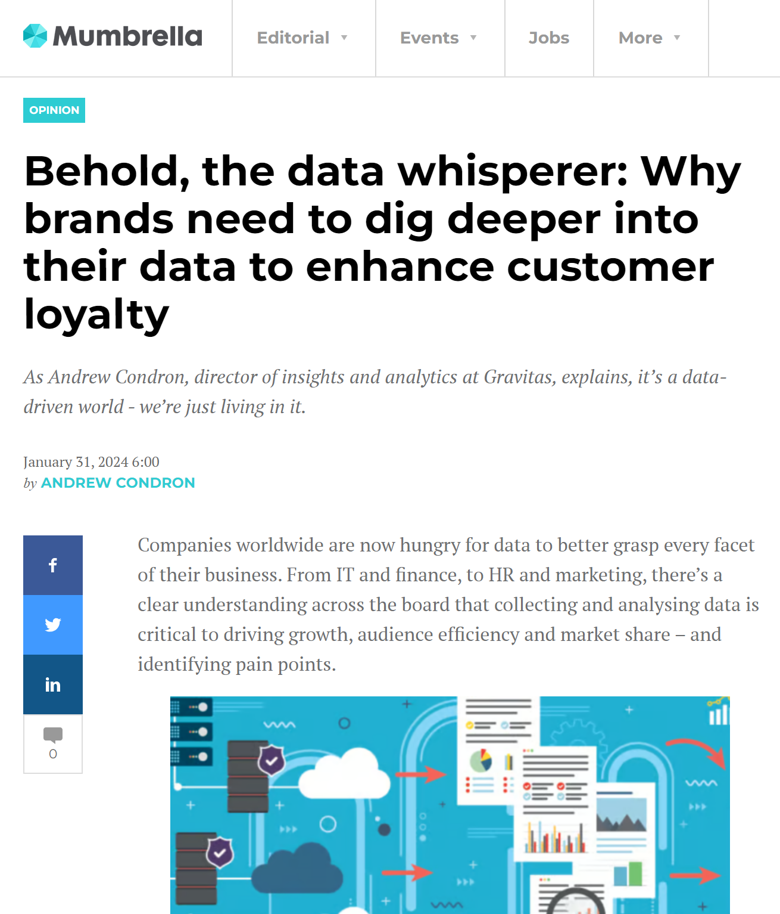As Andrew Condron, Director of Insights and Analytics at Gravitas, explains, it’s a data-driven world – we’re just living in it.
Companies worldwide are now hungry for data to better grasp every facet of their business. From IT and finance, to HR and marketing, there’s a clear understanding across the board that collecting and analysing data is critical to driving growth, audience efficiency and market share – and identifying pain points.
Businesses are acutely aware that to elevate, they need to leverage insights and analytics to make strategic decisions and gain better ROI. Gone are the days of companies simply using data reactively. Now, smart brands are harnessing their data to better understand their customers and create strategies that anticipate customer needs. Additionally, they’re sharing data sets company-wide – they understand knowledge is power, and there’s utility in giving frontline staff access to insights to help make informed decisions in real-time.
Changes to the way brands use their data couldn’t come at a better time. Reforms to the nation’s consumer privacy regulations are looming, which will make it more difficult for businesses to collect and store private information. Given the impending changes, businesses will need to deploy their data more strategically and in a privacy-safe and trusted manner to optimise their current customer base and reach new audiences.
Enter the rise of the customer value index (CVI) – a critical data set used by brands to understand the true value of their customers, and make changes to better meet their needs.
To establish a solid CVI, companies need to firstly assess the direct financial contribution of each customer. Look at everything from purchase frequency, length of tenure, categories shopped, average transaction value, and overall spend. By analysing these factors and current revenue, brands are able to have a clearer picture of the immediate economic value a customer brings.
This data can also help predict the future value a customer is likely to bring to the business. CVI allows businesses to examine long-term revenue potential, including future spending, and the likelihood of customer loyalty.
And when it comes to loyalty, brands need to lean into their long-time customers more than ever to drive revenue. When times are tough (hello cost-of-living crisis!), it’s dedicated customers who will help boost sales and ensure sustainability for when growth returns. An important factor of CVI is longevity – look at how long a customer has been with the business and why and use this to determine their likelihood to return.
But it’s not just about spend. Brands should consider a holistic approach – go beyond the transactions and integrate behavioural, psychographic and demographic elements to truly understand your customer value. Investigate engagement, purchasing patterns and lifestyle changes for a more comprehensive view. A full-scale approach will also help predict future customer behaviour, allowing brands to proactively tailor their strategies, particularly around cultivating relationships with high potential customers for future returns. It’s about using the data to work smarter, not harder, focusing on high-value and high-potential customers who are likely to drive business.
Given the economic climate, it’s critical for brands to grab every opportunity to enhance customer value. A seamless customer journey is a good starting point. Map out the entire customer journey across all channels to identify key touchpoints. Then, use the data to understand behaviour at each stage for targeted interventions, and examine any steps that need improvement. Post-pandemic, customer expectations are at an all-time high. In order to maintain sales and market share, brands need to ensure the end-to-end customer journey is efficient, easy to navigate and as friction-free as possible.
Businesses also need to be smart with their data. Use data-driven segmentation to tailor offerings to different target audiences. Personalisation will continue to be a key marketing trend in 2024 as customers look for brands who appeal directly to their individual needs.
And don’t forget the holy grail of good customer relations: feedback. Look for opportunities to gather customer feedback and use the data – don’t just collect and forget. Integrate customer feedback into your CVI model to ensure you’re enhancing value and responding to changing preferences.
We know the AI tech revolution is well underway – and it’s not going anywhere. For brands looking to truly harness their data sets, now is the time to invest in predictive analytics and models to help forecast future customer behaviour. As moves to cookie-less environments loom and privacy laws tighten, brands will need to leverage technology to help effectively identify high-potential segments and target them accordingly.
As consumers tighten their purse-strings, well-established customer relations will be vital in driving revenue. Brands should go back to basics and focus on building long-term customer relationships. Swap one-off sales for long-lasting relationships, that will see customers coming back time and time again. Loyalty matters – and it’s engaged, rewarded customers that have higher lifetime value.
Finally, start incorporating privacy considerations across the board. The impending changes to privacy laws reflect a national customer desire for more control over their data. It presents an opportunity for brands to get ahead of the curve, and start weaving privacy considerations into online platform usage, loyalty programs and customer value models. Be transparent with customers about how their data is used to build trust and further enhance loyalty.
Andrew Condron, Insights and Analytics Director, Gravitas
If you’d like to learn more about our Customer Value Management approach please reach out today.



